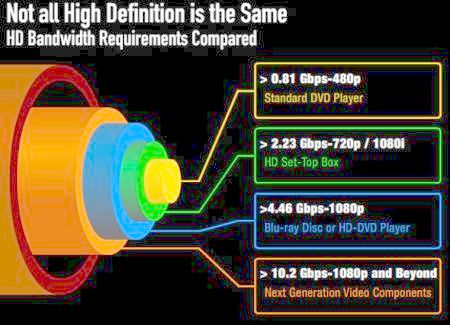Monster Brings HDMI Up to Speed

According to MonsterCable, different HDMI signal sources require cables that support specific ranges of speed. For standard DVD-Video, you need just 0.81 gigabits per second. Speed need rises to 2.23Gbps for an HD set-top box, 4.46Gbps for a Blu-ray or HD DVD disc player, and 10.2 Gbps for what Monster calls "next generation video components."
The wrong cable can harm picture quality, the Monster website asserts: "Under less than ideal circumstances, poorly constructed cables can introduce artifacts into your picture, which are often wrongly attributed to the display. Bit error often appears as color blocking, dropped pixels, flashing pixels, streaks, and other visual aberrations."
The site also quotes Joel Silver of the Imaging Science Foundation: "Micro blocking and video noise can be introduced by fragile cables and easily confused with HDTV noise."
In an informal background interview on a forthcoming top-of-the-line surround receiver, I asked if different HDMI cables made an audible difference. My source said definitely yes, citing both jitter and speed as serious HDMI quality issues. He did not want to be quoted by name or tout any specific brand.
In "Life Is Tough for an HDMI Cable," heir to the legendary Monster white paper "Life Is Tough for an Audio Signal," Head Monster Noel Lee describes how a premium HDMI cable is manufactured: "Monster slows down the cable winding machine to a fraction of its regular speed to better control the shape of the twist." Also contributing to build quality are oversized conductors, careful soldering, high-frequency shielding protected by a solid metal shell, and a mesh jacket that protects the cable when it is bent and turned for an in-wall installation.
For more details, see the Monster Education Center for HDMI.
- Log in or register to post comments





























































